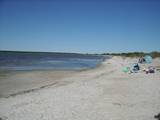In order to ensure you that it is really huge, we it is said that Lake Winnipeg is the 11th largest freshwater lake on Earth.
And, it isn't the largest lake in Southern Canada, but it isn't only the size but the beauty and the uniqueness which makes Lake Winnipeg in Manitoba a United Nations World Heritage Park.
It is elongated in size and it is 416 kilometers from north to south. It offers remote sandy beaches, limestone caves, and bat caves in the same area.
Due to its long and narrow shape, Lake Winnipeg Manitoba displays interesting wind and wave effects including waves up to one meter in height at its southern shore, a process called wind tide. This effect occurs when strong northerly winds blow across the Lake Winnipeg Manitoba that exerting a horizontal stress on its surface.
Setups greater than one meter above normal lake levels have been recorded along many of the Southern Lake Winnipeg's recreational beaches. The associated waves with their up rush effects have caused considerable storm damage, backshore floods, and shoreline erosion. The highest setups occur in the fall when the northerly winds are at their strongest.
Communities on the eastern shore of Lake Winnipeg
Communities on the lake include: Grand Beach, Riverton, Gimli, Winnipeg Beach, Victoria Beach, Pine Falls, Manigotagan, Berens River, and Grand Rapids. A number of pleasant beaches are at the southern end of the lake. Lake Winnipeg serves many commercial fisheries, shipping routes, and the southern shore is a popular summer resort area.
Eco-Tourism
Naturally, Lake Winnipeg Manitoba has an excellent ecotourism potential with nothing else like it in Southern and Central Canada. For example, a short drive from highway 59, you will find the most famous strips of sand along Lake Winnipeg Manitoba named Grand Beach. This breathtaking beach has drawn tourists from across the continent since the 1920s and features mile after mile of clean white silica sand, and backed up by sand dunes as high as eight meters.
It is an excellent place to swim, sunbathe, fish, windsurf, stroll, or just people watch. In the winter the beach attracts snowmobilers and cross country skiers who come for the many excellent trails in the area. It is truthfull to describe the beaches as excellent. Lake Winnipeg has something to offer you for example: pleasant country sites.
Grand Beach Provincial Park, the home of the endangered Piping Plover is situated with wonderful picnic and camping areas that are certainly worth a trip. Near Lake Winnipeg, well to be exact, a few minutes drive from it; you will see a small resort town adjacent to the park. This is called Grand Marais which provides all of the services that will make your stay more enjoyable with nice country inns, sweet parks, wonderful views, and friendly people.
The town traces its name back to 1734 when the area was marked on the map with the words Grand Marais or big marsh in English. Today the town's population increases during the summer, because cottages and tourists stream into the area to enjoy the many resort and entertainment chances it offers.
For wildlife lovers, a trip to Grand Marais may uncover some interesting sightings of much wildlife such as bears, and various raptors through out the year.
The Eastern Beaches Area of Lake Winnipeg need Protection and Promotion
If you have a unique geological and geographical location that is largely underdeveloped and quite a rare ecological gem in the world today, it needs both protection and promotion.
That is why there are a great number of Provincial Protection Programs for Lakes such as the one for Lake Manitoba Canada.
Author: Fredrick Buetefuer


